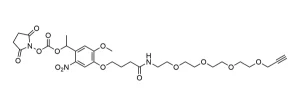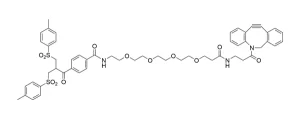Amino-dPEG®4-OH, product number QBD-10249, is a monodisperse PEGylation reagent designed for chemical modification of biomolecules and surfaces. The primary amine on one end of the molecule reacts with carboxylates to form amide bonds and with aldehydes and ketones to form labile Schiff bases. The hydrophilic, non-immunogenic, discrete polyethylene glycol (dPEG®) spacer improves water solubility and increases the hydrodynamic volume of conjugates. The terminal hydroxy group can be modified to add different functional groups.
When used to modify biomolecules or passivate surfaces, amino-dPEG®4-OH creates an extremely hydrophilic coating on the modified surface or molecule. The primary amine on one end of the dPEG® linker reacts with carboxylates, aldehydes, and ketones. Conjugations with this molecule most commonly use the amine-carboxylate reaction because it forms stable amide bonds. A carbodiimide such as EDC directly connects the amino group to a carboxylate. Alternatively, activation of carboxylate as the NHS or TFP ester followed by reaction under slightly basic conditions also permits conjugation of the carboxylate and amino moieties.
The amino group also reacts with aldehydes and ketones to form Schiff bases. Schiff bases are reducible to secondary amines for improved stability.
The published uses of Amino-dPEG®4-OH include the following:
Surface coating of iron oxide nanoparticles;
Surface coating of quantum dots;
Development of a confocal imaging system to measure passive transport across membranes; and,
Development of a label-free detector of pyrophosphate.
| Unit Size | 100 mg, 1000 mg |
|---|---|
| Molecular Weight | 193.24; single compound |
| Chemical formula | C₈H₁₉NO₄ |
| CAS | 86770-74-3 |
| Purity | > 98% |
| Spacers | dPEG® Spacer is 13 atoms and 14.3 Å |
| Shipping | Ambient |
| Typical solubility properties (for additional information contact Customer Support) | Methylene chloride, DMAC, DMSO or water. |
| Storage and handling | -20°C; Always let come to room temperature before opening; be careful to limit exposure to moisture and restore under an inert atmosphere; stock solutions can be prepared with dry solvent and kept for several days (freeze when not in use). dPEG® pegylation compounds are generally hygroscopic and should be treated as such. This will be less noticeable with liquids, but the solids will become tacky and difficult to manipulate, if care is not taken to minimize air exposure. |
Greg T. Hermanson, Bioconjugate Techniques, 3rd Edition, Elsevier, Waltham, MA 02451, 2013, ISBN 978-0-12-382239-0; See Chapter 18, Discrete PEG Reagents, pp. 787-821, for a full overview of the dPEG® products.
Label-Free Detection of Proteins in Crude Cell Lysate with Antibody Arrays by a Surface Plasmon Resonance Imaging Technique. Motoki Kyo, Kazue Usui-Aoki, and Hisashi Koga. Analytical Chemistry. 2005, 77 (22), pp 7115–7121. October 18, 2005. DOI: 10.1021/ac050884a.
Development of an oligo (ethylene glycol)-based SPR immunosensor for TNT detection. Yutaka Mizuta, Takeshi Onodera, Praveen Singh, Kiyoshi Matsumoto, Norio Miura, Kiyoshi Toko. Biosensors and Bioelectronics. 2008, 24 (2), pp 191-197. October 15, 2008. DOI:10.1016/j.bios.2008.03.042.
Real-Time Video Imaging of Protease Expression In Vivo. Lei Zhu, Jin Xie, Magdalena Swierczewska, Fan Zhang, Qimeng Quan, Ying Ma, Xuexun Fang, Kwangmeyung Kim, Seulki Lee, Xiaoyuan Chen. Theranostics. 2011, (1) pp 18-27. January 12, 2011. http://www.thno.org/v01p0018.htm.
Confocal imaging to quantify passive transport across biomimetic lipid membranes. Su Li, Peichi Hu, and Noah Malmstadt. Analytical Chemistry. 2010, 82 (18) pp 7766-7771 September 15, 2010. DOI: 10.1021/ac1016826.
Label-free electrical detection of pyrophosphate generated from DNA polymerase reactions on field-effect devices. Grace M. Credo, Xing Su, Kai Wu, Oguz H. Elibol, David J. Liua, Bobby Reddy Jr., Ta-Wei Tsai, Brian R. Dorvel, Jonathan S. Daniels, Rashid Bashir, and Madoo Varma. Analyst. 2012, 137 (6) pp 1351-1362. March 21, 2012. DOI:10.1039/c2an15930a.
Synthesis of Biotinylated r-D-Mannoside or N-Acetyl _-D-Glucosaminoside Decorated Gold Nanoparticles: Study of Their Biomolecular Recognition with Con A and WGA Lectins. Xiaoze Jiang, Abdelghani Housni, Guillaume Gody, Paul Boullanger, Marie-The´re`se Charreyre, Thierry Delair, and Ravin Narain. Bioconjugate Chem. 2010, 21 pp 521–530. February 3, 2010. DOI: 10.1021/bc900431p.
Surface Chemical Functionalization of Cylindrical Nanopores Derived from a Polystyrene−Poly(methylmethacrylate) Diblock Copolymer via Amidation. Yongxin Li and Takashi Ito. Langmuir. 2008, 24 (16) pp 8959–8963. July 1, 2008. DOI: 10.1021/la800992f.
Permeation Studies across Symmetric and Asymmetric Membranes in Microdroplet Arrays. Simon Bachler, Marion Ort, Stefanie D. Krämer, and Petra S. Dittrich. Analytical Chemistry. 2021. Volume 93, 12, 5137-5144. 03/31/2021. https://doi.org/10.1021/acs.analchem.0c04939
Applicable patents and legal notices are available at legal notices.




Stay in the Loop. Join Our Online Community
Products
Ordering
About Us
Application
Resources

©Vector Laboratories, Inc. 2025 All Rights Reserved.
To provide the best experiences, we use technologies like cookies to store and/or access device information. Consenting to these technologies will allow us to process data such as browsing behavior or unique IDs on this site. Not consenting or withdrawing consent, may adversely affect certain features and functions. Privacy Statement
How do I Request a Quote?
To request a quote for products: